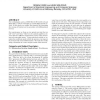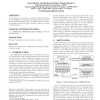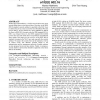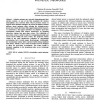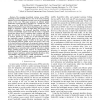SIMUTOOLS
2008
14 years 29 days ago
2008
New technologies such as IEEE 802.16 (Wi-MAX) [2] and IEEE 802.11e (Wi-Fi with QoS) [1] enable differentiated services. In this study we explore the potential for increasing the r...
CONEXT
2006
ACM
14 years 5 months ago
2006
ACM
In this paper, we propose an alternative QoS architecture for the IEEE 802.16 Standard, that incorporates a priority based packet scheduling and a new traffic shaping. For this, w...
ACMSE
2006
ACM
14 years 5 months ago
2006
ACM
Without physical boundaries, a wireless network faces many more security threats than a wired network does. Therefore, in the IEEE 802.16 standard a security sublayer is specified...
VTC
2006
IEEE
14 years 5 months ago
2006
IEEE
— Adaptive antennas are currently being integrated into wireless systems. As one of the first standards the wireless metropolitan area network IEEE 802.16 provides means to suppo...
EUROPAR
2007
Springer
14 years 5 months ago
2007
Springer
The IEEE 802.16 mobile multi-hop relay (MMR) task group ’j’ (TGj) has recently introduced the multi-hop relaying concept in the IEEE 802.16 WirelessMAN, wherein a newly introdu...
PIMRC
2008
IEEE
14 years 6 months ago
2008
IEEE
Wireless mesh networks (WMNs) are one of the key features of beyond 3G system because of their flexible and lowcost deployment. IEEE 802.16 mesh mode has recently emerged as an alt...
INFOCOM
2008
IEEE
14 years 6 months ago
2008
IEEE
—The emerging broadband wireless access (BWA) technology based on IEEE 802.16 is one of the most promising solutions to provide ubiquitous wireless access to the broadband servic...
ICC
2008
IEEE
14 years 6 months ago
2008
IEEE
The IEEE 802.16/WiMAX standard has fully embraced multi-antenna technology and can, thus, deliver robust and high transmission rates and higher system capacity. Nevertheless, due ...
IWCMC
2009
ACM
14 years 6 months ago
2009
ACM
The IEEE 802.16/WiMAX standards has fully embraced multi-antenna technology and can, thus, deliver robust performance and high transmission rates. Nevertheless, due to its inheren...
